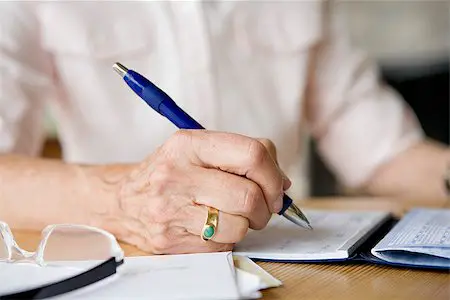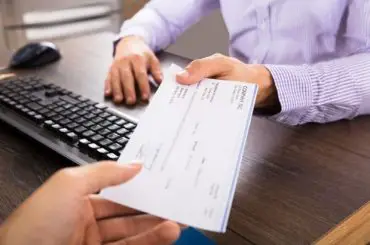Information presented on this web page is intended for informational and educational purposes only and is not meant to be taken as legal, financial, investment or tax advice. We do not accept any responsibility for any trading or investment related losses. Please review our disclaimer on before taking action based upon anything you read or see.
How can I get rid of old checkbooks? When you have these pieces of paper that you would ordinarily toss out without further consideration, this is a question that comes to mind a lot. However, you need to be more cautious and follow the proper procedures when it comes to your financial details. Private information is present in all financial records, which must not fall into the wrong hands. As a result, we’ve prepared this post to help you figure out how to dispose of unused checkbooks.
Checkbooks are not like other waste paper placed into the trash bin and ignored once used. Instead, a check leaf is a receptacle for personal information that you should never exchange with strangers. There are diverse reasons why someone might desire to get rid of their old checkbooks.
One explanation could be a disgruntled consumer closing a bank account. Another possibility is relocating or resettling elsewhere, or even marital problems. However, in the last decade, the most common reason for checkbook dumping has been declining checkbook usage in the United States.
The use of checkbooks has been decreasing at a pace of roughly 7% each year in the United States. It has reduced from an all-time high of 42 billion check payments in 2019 to a little over 14 billion check transactions in 2020. Businesses and the authorities write the majority of the checks (almost 60%). Consumers’ written checks account for roughly 40% of annual check payments in the United States.
Furthermore, some people do not use checks at all. As a result, many thousands of checkbooks have become outdated and neglected over the last decade, with their owners seemingly unconcerned. Thus, you can find them in residences, abandoned in trash bags, and thrown into garbage chutes.
Why is it Important to Get Rid of Unused Checkbooks?
The bank provides its customers with a checkbook, which is a bundle of check leaves. The customer’s name, account number, and routing number are all written on a check leaf. Furthermore, every check is labeled with a number, allowing each torn sheaf to get identification.
Unused or canceled checks usually have even more information on them, such as signature verification, names, social security numbers, and so on. This information can be extremely harmful to the owner if it falls into the wrong hands.
Anyone can take on a false identity and obtain loans and credit in the name of the checkbook owner. This scam can be so risky that false identity documents can emerge using the information from the discarded checkbook.
Because the scammer can imitate the checkbook holder and take advantage of their financial resources, this can jeopardize the checkbook owner’s identity. As a result, the data on the checks can undergo usage in a variety of ways. As a result, every bank that grants checkbooks advises that you discard old checkbooks as soon as they are no longer needed.
How to Dispose of Unused Checkbooks

Checkbooks are paper products. They are subject to all of the methods for dealing with paper waste. On the other hand, checkbooks contain sensitive information that can do significant harm in the wrong hands. Thus it is preferable to be cautious rather than negligent while disposing of them. You can dispose of checkbooks at home or through a consumer’s business, both of which are safe and reliable. Here are a few options for dealing with this:
Request that the bank disposes of any unused checkbooks.
Because of security concerns, most banks enable customers to send unused checkbooks for destruction. This is in addition to inexperienced clients disposing of these private data in an insecure manner. A checkbook owner can ask their bank if they accept unused checkbooks that need shredding by calling them. If the bank responds affirmatively, return the unused checkbooks to the bank, where they will undergo secure shredding by bank workers per safety standards and regulations. As a result, no personally identifiable information will be released or represent a security risk in the future.
However, this action may not always be possible because some banks may not have physical locations in a given area, city, or even country. Therefore, seeking out additional secure and safe professional or home disposal options is preferable in these situations.
Using bleach to pulp and destroy the unused checkbooks
Soaking unused checkbooks in bleach converts the paper into a pulpy paste that comes apart, rendering all writing illegible. Filling a massive tub with water, adding a little bleach, and drowning the checkbooks in it is the easiest way to pulp a bundle of checkbooks or just one checkbook. However, the results of the water and bleach solution may take a few days to appear.
The rate of disintegration will be accelerated if there is more bleach in the solution. Undiluted bleach has an immediate effect on checkbooks. Because bleach is corrosive, it degrades the structure of the paper. It also destroys the ink, which bleeds out of the paper at the start of the process. This is due to repeated submersion in a corrosive environment.
Before discarding the paper pulp obtained from the procedure, you should dry it. Because bleach has a strong odor, this procedure should occur in an open area with plenty of ventilation.
Using baking soda to pulp
Submerging unused checkbooks in a mixture of baking soda and water is another option for getting rid of them. The paper will break down if you use baking soda. The ink oozes out of the paper and settles in the water after days of submersion. This solution is less caustic than bleach, although results may take up to a week to appear.
The results are dependent on the amount of baking soda in the water: a more significant portion of baking soda will cause the paper to disintegrate faster. This procedure is also safe for the environment. The final product can be composted or used to make paper mâché decorations.
Washing the checkbooks
Washing unused checkbooks is an excellent way to get rid of them. Unfortunately, the spinning action of the washing machine, along with the documents’ immersion in water, causes the paper to split apart into shards. This procedure can destroy checkbooks.
Instead, put as many checkbooks as you need in a strong canvas bag. Then put the canvas bag inside the washing machine, add the detergent, and start it up.
The paper will begin to unravel after a few minutes of wiggling around. After a few cycles, the paper will start to degrade and split into tiny pieces. Remove the bag after a few spinning cycles and dry the paper before tossing it in the garbage or composting it. This approach is a bit clumsy, but it is pretty secure and relatively safe to use.
Cutting the checkbook
Although a cross-cut shredder is an ideal option for destroying unneeded checkbooks, another method is to use a scissor to cut each checkbook leaf into bits separately. Again, it is preferable to shred the leaf evenly rather than concentrating on the areas containing personal data such as the routing number, account number, and any private details such as a name or address.
Cut the parts as small as possible to reduce the chances of tampering or recombining by scammers or exploiters, especially those containing confidential information. This makes it nearly tough to reconstruct the entire check, reducing the security risk to the checkbook holder.
Ripping the checkbook into pieces
Another approach is to rip the checks up into tiny pieces. This is the same as cutting a checkbook with a scissor. Instead of concentrating on the entire check, it is preferable to focus on places with written private data and render them unusable. However, because this is a time-consuming operation, it may not be a realistic option to eliminate many unused checkbooks.
Frequently Asked Questions
What’s the best way to get rid of unused checkbooks?
The following are some of the most acceptable ways to get rid of your unused checkbooks:
- Request that the bank disposes of any unused checkbooks.
- Paper shredding
- Cutting the Checkbook
- Using Baking Soda to Pulp
Is it necessary to shred unused checkbooks from an account that has been closed?
Yes. Because checks contain your bank account information, shredding unused checkbooks reduces the risk of someone stealing your identity.
When it comes to checkbooks, how long do they last?
The checkbook will last for years if you don’t write anything on it. If you come across a check with writing on it, such as a date, an amount, and a signing, it will have an expiration date. If a check is over six months old, most banks will not honor it.
What are outstanding checks?
Checks that have not been posted or cashed by the receiver are known as outstanding checks. However, the payer still holds the money in their account because the recipient hasn’t paid the check. Therefore, the payor owes the payee funds. Hence the payment is considered a responsibility.
Conclusion
In conclusion, checks come with various merits. But disposing of them wrongly can land you in trouble. Thus, the highlight on how to dispose of unused checkbooks above will aid you immensely.




